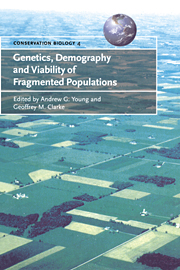Book contents
- Frontmatter
- Contents
- List of contributors
- Foreword by Peter F. Brussard
- Preface
- 1 Introduction: genetics, demography and the conservation of fragmented populations
- Part I Introductory concepts
- Part II Animal case studies
- 8 Inbreeding in small populations of red-cockaded woodpeckers: insights from a spatially explicit individual-based model
- 9 Genetic erosion in isolated small-mammal populations following rainforest fragmentation
- 10 The Tumut experiment – integrating demographic and genetic studies to unravel fragmentation effects: a case study of the native bush rat
- 11 Demographic evidence of inbreeding depression in wild golden lion tamarins
- 12 Inferring demography from genetics: a case study of the endangered golden sun moth, Synemon plana
- 13 Genetic population structure in desert bighorn sheep: implications for conservation in Arizona
- Part III Plant case studies
- References
- Index
8 - Inbreeding in small populations of red-cockaded woodpeckers: insights from a spatially explicit individual-based model
Published online by Cambridge University Press: 29 January 2010
- Frontmatter
- Contents
- List of contributors
- Foreword by Peter F. Brussard
- Preface
- 1 Introduction: genetics, demography and the conservation of fragmented populations
- Part I Introductory concepts
- Part II Animal case studies
- 8 Inbreeding in small populations of red-cockaded woodpeckers: insights from a spatially explicit individual-based model
- 9 Genetic erosion in isolated small-mammal populations following rainforest fragmentation
- 10 The Tumut experiment – integrating demographic and genetic studies to unravel fragmentation effects: a case study of the native bush rat
- 11 Demographic evidence of inbreeding depression in wild golden lion tamarins
- 12 Inferring demography from genetics: a case study of the endangered golden sun moth, Synemon plana
- 13 Genetic population structure in desert bighorn sheep: implications for conservation in Arizona
- Part III Plant case studies
- References
- Index
Summary
ABSTRACT
Inbreeding depression can be a critical factor affecting viability of small populations and may be especially dangerous in combination with demographic and environmental stochasticity. For species with fragmented habitats and declining, isolated populations, estimating the threat of inbreeding depression is an urgent conservation need. In previous work, we documented inbreeding depression in a wild population of red-cockaded woodpeckers, an endangered, co-operatively breeding species that was once widespread but is now restricted to remnant patches of mature pine savannas in the south-eastern United States. Here, we investigated how rapidly inbreeding accumulates in red-cockaded woodpecker populations of varying size and with varying rates of immigration, using a spatially explicit individual-based simulation model of population dynamics. With this approach, we were able to assess the accumulation of inbreeding in the presence of environmental and demographic stochasticity, while also accounting for effects of the complex social system and extremely restricted dispersal of our study species. We found several meaningful results: (i) most populations were declining, (2) substantial inbreeding accumulated in small, declining populations with limited immigration, due mainly to high percentages of closely related pairs (numbering from 40% to ioo% of all pairs after 50 years) and (3) moderately high levels of immigration (two or more migrants per year, equalling four effective migrants per generation) were required to stabilise small declining populations and obtain a mean inbreeding level under 0.10. We conclude that inbreeding depression is a very serious threat to the viability of the many small, isolated and declining populations of red-cockaded woodpeckers.
- Type
- Chapter
- Information
- Genetics, Demography and Viability of Fragmented Populations , pp. 129 - 148Publisher: Cambridge University PressPrint publication year: 2000
- 13
- Cited by

